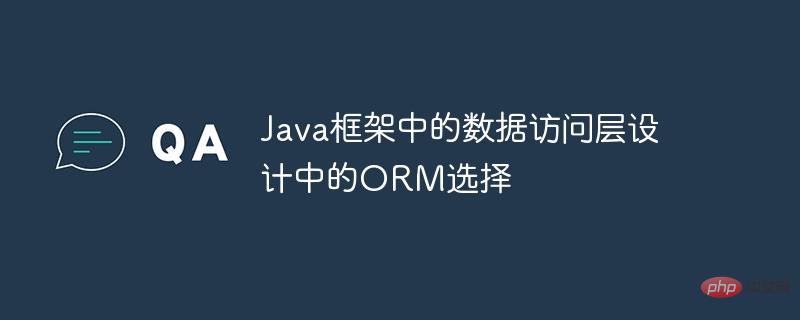Home >Java >javaTutorial >ORM selection in data access layer design in Java framework
ORM selection in data access layer design in Java framework
- PHPzOriginal
- 2024-06-04 15:21:01678browse
This guide guides readers in choosing an ORM framework suitable for their Java applications. Advantages include increased efficiency, simplified persistence management, and decoupling database technical details. Common frameworks include Hibernate, Spring Data JPA, MyBatis and jOOQ. Selection factors include functionality, performance, learning curve, and community support. The sample DAL design uses Hibernate to interact with the MySQL database, including entity classes, warehouse interfaces and service classes, demonstrating the process of ORM simplifying data access.

Data Access Layer (DAL) Design in Java Framework: ORM Selection Guide
The Data Access Layer (DAL) is the core component of any Java application part, which is responsible for interacting with the database. Object-relational mapping (ORM) framework plays a crucial role in DAL design, simplifying persisting data objects. This article will guide you through choosing an ORM framework that suits your application needs.
Advantages of the ORM framework
Using the ORM framework provides many advantages, including:
- Improving development efficiency
- Simplifying persistence management
- Isolate application code from database technical details
- Enhance code maintainability
Common ORM frameworks
There are many popular ORM frameworks Available options include:
- Hibernate: The industry-leading ORM framework with a wide range of features.
- Spring Data JPA: An extension to the Spring framework that provides easy abstraction of the JPA standard.
- MyBatis: High-performance ORM framework focusing on flexibility and control.
- jOOQ: An ORM framework written in pure SQL, providing maximum performance.
Choose the best ORM for your application
Choosing the best ORM framework depends on the needs of your application. Here are some key factors:
- Features: Evaluate the features provided by the ORM framework, such as cascading operations, lazy loading, and transaction management.
- Performance: Consider the performance requirements of your application and choose an ORM framework that can meet those needs.
- Learning Curve: Consider the learning curve of an ORM framework that matches your team’s skills.
- Community Support: Evaluate community support for the ORM framework, as well as available documentation and examples.
Practical Case
Consider a simple Spring Boot application that needs to interact with a MySQL database. The following is an example DAL design using Hibernate:
// Entity class
@Entity
public class User {
@Id
@GeneratedValue(strategy=GenerationType.AUTO)
private Long id;
private String name;
private String email;
}
// Repository interface
public interface UserRepository extends JpaRepository<User, Long> {}
// Service class
@Service
public class UserService {
private UserRepository userRepository;
@Autowired
public UserService(UserRepository userRepository) {
this.userRepository = userRepository;
}
public User create(User user) {
return userRepository.save(user);
}
public User find(Long id) {
return userRepository.findById(id).orElse(null);
}
}In this example, Hibernate is used to persist the User object and manage the interaction with the database. Spring Data JPA provides the JpaRepository interface to simplify warehouse operations.
The above is the detailed content of ORM selection in data access layer design in Java framework. For more information, please follow other related articles on the PHP Chinese website!

